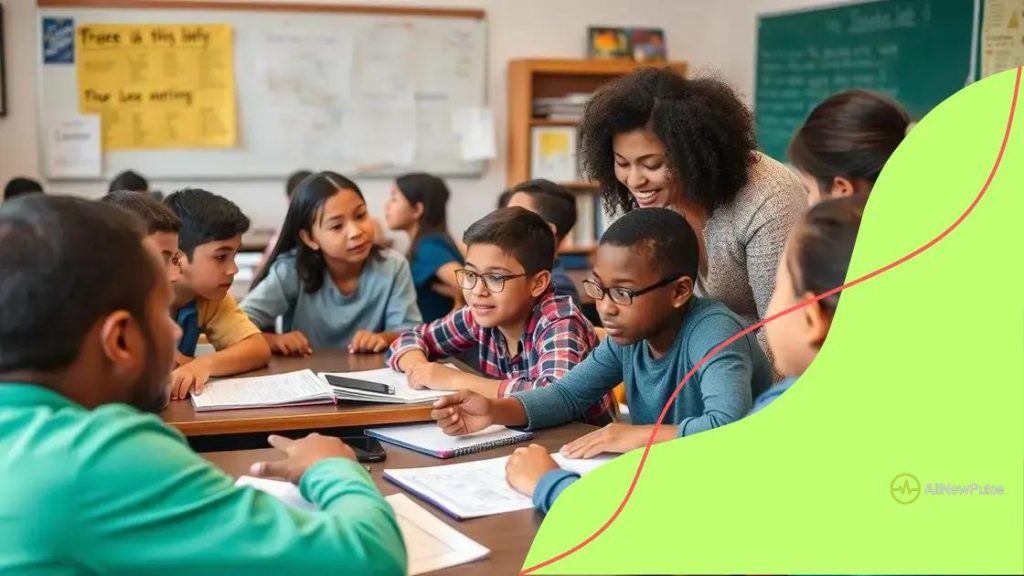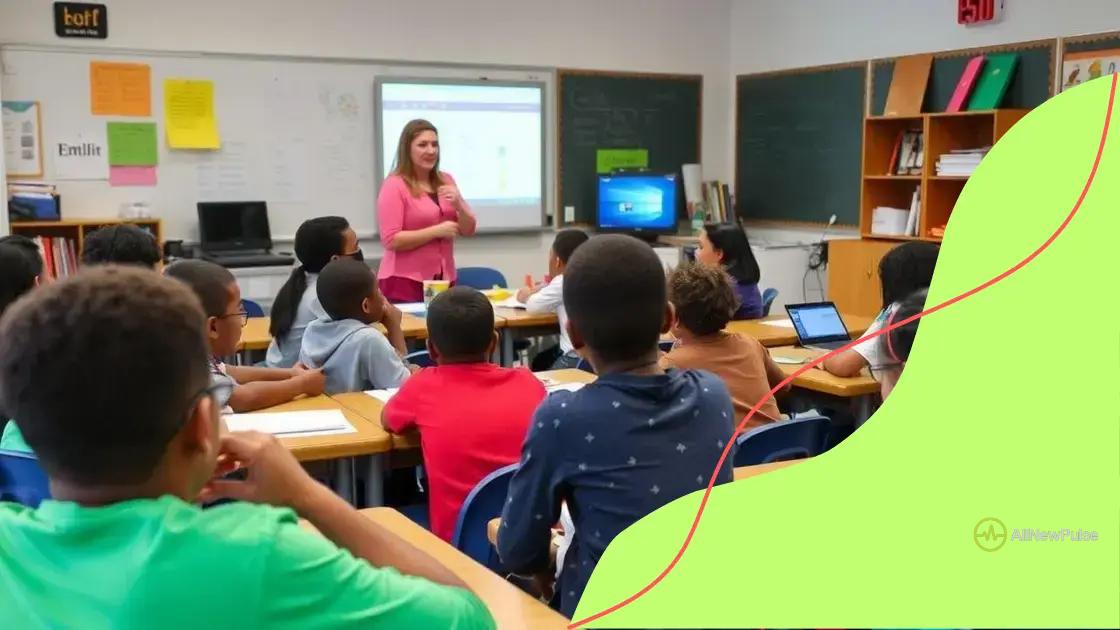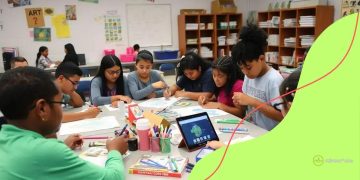Supporting English language learners: tips and strategies

Supporting English language learners involves understanding their unique needs, creating inclusive environments, utilizing technology effectively, and providing constructive feedback to enhance their learning experiences.
Supporting English language learners can dramatically enhance their educational journey. Have you ever wondered how tailored strategies can empower these students to thrive? Let’s dive into practical techniques that can make a real difference.
Understanding the needs of English language learners
Understanding the needs of English language learners is essential for creating an effective learning environment. Every student has unique challenges that require attention and tailored strategies. Recognizing these needs can enhance their educational experience greatly.
Diverse backgrounds
Students come from various cultural backgrounds, and their previous educational experiences shape how they learn English. Some may have had formal education, while others may have not. Understanding these differences helps teachers to address individual challenges.
- Identifying language proficiency levels
- Recognizing varying degrees of academic background
- Understanding cultural differences in learning styles
Moreover, many students are navigating a new culture alongside learning a new language. This dual challenge can be overwhelming, making it vital to provide support and build a trusting relationship in the classroom. Teachers can create a safe environment that encourages open communication.
Supportive strategies
To effectively support English language learners, educators should use strategies that cater to individual needs and promote language growth.
- Incorporating visuals and hands-on activities
- Using clear and simple language
- Encouraging peer interactions and group work
By focusing on these strategies, teachers can better address the diverse needs of their students. Creating an inclusive atmosphere allows all learners to thrive, increasing their confidence and engagement.
Ultimately, recognizing and understanding the specific needs of English language learners leads to more effective teaching practices. As educators become aware of the challenges their students face, they can implement supportive measures that foster success.
Creating an inclusive classroom environment
Creating an inclusive classroom environment is crucial for English language learners. A welcoming space encourages participation and supports diverse learning needs. When students feel included, they are more willing to engage and express themselves.
Welcoming atmosphere
To foster a welcoming environment, teachers can incorporate elements that reflect the diverse backgrounds of their students. This includes using materials that represent various cultures, languages, and experiences. In doing so, students see their identities valued.
- Display student work that highlights different cultures
- Use multilingual labels around the classroom
- Encourage students to share their cultural stories
Additionally, establishing classroom rules that promote respect and kindness helps in building a strong community. Creating opportunities for students to collaborate encourages peer relationships, enhancing social skills.
Flexibility in teaching
Flexibility is key in teaching techniques for English language learners. Adapting lessons to meet varying proficiency levels ensures that all students can engage with the material. Using visual aids, hands-on activities, and interactive lessons makes learning accessible.
- Provide sentence starters to assist in language production
- Incorporate group activities that allow for peer support
- Utilize technology tools that support language learning
By employing a variety of teaching strategies, educators can address the unique needs of each student. These adaptations make it possible for everyone to thrive in an inclusive classroom.
Moreover, fostering open communication is essential. Encouraging students to express their thoughts and concerns helps build trust. When learners feel comfortable, they are more likely to participate actively.
Effective teaching strategies for diverse learners

Effective teaching strategies for diverse learners are essential to support English language learners. By using varied approaches, educators can engage students and help them succeed. Tailoring instruction to different needs makes learning more impactful.
Differentiated instruction
Differentiated instruction allows teachers to meet individual learning needs. This process involves adjusting the content, process, and products of learning based on student readiness and interests. By doing so, teachers can ensure that every student is challenged appropriately.
- Modify assignments to fit skill levels
- Offer choices in learning activities
- Provide various ways to demonstrate understanding
Additionally, incorporating multimodal resources enhances learning. These can include videos, graphic organizers, and hands-on activities. When students engage with the material in different ways, they retain information better.
Collaborative learning
Another key strategy is collaborative learning. This method encourages students to work together and learn from one another. Peer interactions can create a supportive environment where English language learners feel more comfortable practicing their skills.
- Use group projects to foster teamwork
- Implement buddy systems for language support
- Encourage discussions in small groups
By fostering collaboration, students develop not only language skills but also social connections. This approach can lead to a more inclusive classroom where everyone feels valued.
Teachers can also integrate culturally relevant materials into the curriculum. When students see their backgrounds reflected in the content, they feel a sense of belonging. This connection can increase motivation and engagement.
Utilizing technology to support language learning
Utilizing technology to support language learning can greatly enhance the experience for English language learners. With the right tools, students can engage more effectively and make significant progress in their language skills. Technology offers various resources that can cater to different learning styles and needs.
Digital tools for interactive learning
Interactive apps and programs are invaluable for language acquisition. These tools often include games and quizzes that make learning fun and engaging. They can provide immediate feedback, allowing students to understand their mistakes and learn from them.
- Language learning apps like Duolingo or Babbel
- Interactive websites that offer exercises and practice
- Virtual flashcards for vocabulary building
Moreover, teachers can incorporate multimedia resources such as videos and podcasts into their lessons. These tools can help contextualize language and provide authentic listening practice, giving students exposure to real-world usages of English.
Collaboration through technology
Technology also facilitates collaboration among students. Online platforms enable peer interactions, allowing learners to practice their language skills with one another. Using forums and group chats, students can ask questions and share knowledge in a supportive environment.
- Online collaborative projects using Google Docs
- Video conferencing tools for language exchange
- Discussion boards for peer feedback and support
When students collaborate, they can learn from one another’s perspectives and improve their language skills in the process. Additionally, access to online communities can provide a sense of belonging and motivation for learners.
Finally, integrating technology in assessments can also support English language learners. Online quizzes and interactive assessments can simplify the evaluation process, making it easier for teachers to track progress and for students to engage without the pressure of traditional testing formats.
Assessing progress and providing feedback
Assessing progress and providing feedback is a crucial part of supporting English language learners. Effective assessments help educators understand a student’s capabilities and areas for improvement. By integrating feedback into the learning process, teachers can create a roadmap for student success.
Types of assessments
There are various ways to assess language progress. Educators can use both formative and summative assessments to gauge learning. Formative assessments occur during the learning process and help guide instruction. Summative assessments evaluate learning at the end of a unit or course.
- Quizzes and tests to measure knowledge retention
- Observation of student participation in discussions
- Projects that demonstrate practical application of language skills
These assessments allow teachers to track progress and adapt their teaching strategies. Understanding each student’s unique needs is essential in this process.
Effective feedback
Providing timely and constructive feedback plays a significant role in a student’s development. Feedback should focus on both strengths and areas for improvement, offering specific guidance. This supports English language learners in understanding how to advance their skills.
- Highlighting what a student did well can boost confidence
- Offering suggestions for improvement encourages growth
- Using language that is straightforward and clear aids comprehension
Feedback can take many forms, such as written comments, verbal discussions, or even peer reviews. Using diverse methods ensures that students receive the information in a way that resonates with them.
Additionally, involving students in the assessment process can empower them. Encouraging learners to set personal goals and self-assess can foster a sense of ownership in their learning. When students are aware of their progress, they are more likely to stay motivated and engaged.
In conclusion, effectively supporting English language learners requires a multifaceted approach. By understanding their unique needs, creating inclusive environments, using technology wisely, and providing constructive feedback, educators can significantly enhance their learning experiences. Each strategy plays a vital role in helping learners become successful in their language journey. Together, these elements foster a supportive atmosphere where students can thrive and feel valued.
FAQ – Questions about Supporting English Language Learners
What are effective strategies for teaching English language learners?
Effective strategies include using differentiated instruction, incorporating technology, and providing collaborative learning opportunities.
How can technology enhance language learning?
Technology offers interactive tools, multimedia resources, and platforms for collaboration, making learning more engaging and accessible.
Why is feedback important for language learners?
Feedback helps students understand their strengths and areas for improvement, guiding them in their language development.
How can teachers create an inclusive classroom environment?
Teachers can create inclusivity by reflecting diverse cultures in materials, encouraging collaboration, and fostering a welcoming atmosphere.





